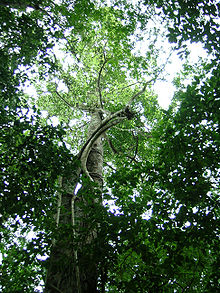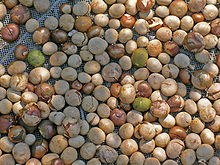- Brosimum alicastrum
-
Breadnut 
Scientific classification Kingdom: Plantae (unranked): Angiosperms (unranked): Eudicots (unranked): Rosids Order: Rosales Family: Moraceae Tribe: Dorstenieae Genus: Brosimum Species: B. alicastrum Binomial name Brosimum alicastrum
Sw.Synonyms Alicastrum brownei Kuntze
Brosimum uleanum Mildbr.
Helicostylis bolivarensis Pittier
Piratinera alicastrum (Sw.) Baill.Brosimum alicastrum, the breadnut or Maya nut, is a Brosimum tree species under the Moraceae family of flowering plants, whose other genera include fig and mulberries The plant is known by a range of names in indigenous Mesoamerican and other languages, including but not limited to: ramon,ojoche, ojite, ojushte, ujushte, ujuxte, capomo, mojo, ox, iximche , masica' in Honduras 'and uje in Michoacan Mexico.
Two subspecies are commonly recognized:
- Brosimum alicastrum ssp. alicastrum
- Brosimum alicastrum ssp. bolivarense (Pittier) C.C.Berg
Distribution and habitat: Southern Mexico-Guatemala-El Salvador, Caribbean, Amazon. Large stands in moist lowland tropical forests 300-2000 m elevation (especially 125-800 m), in humid areas where rainfall of 600-2000 mm, and avgerage temperature 24 C / 75 F. [1]
The breadnut fruit disperses on the ground at different times throughout its range. It has a large seed covered by a thin, citrus-flavored orange-colored skin favored by a number of forest creatures. More important, the large seed which is enveloped by the tasty skin is an edible ‘nut’ that can be boiled or dried and ground into a meal for porridge or flatbread. Breadnut is nutritious and has value as a food source, and formed a part of the diet of the pre-Columbian Maya of the lowlands region in Mesoamerica[2] [3], although to what extent has been a matter of some debate among Maya historians and archaeologists.
It was planted by the Maya civilization two thousand years ago and it has been claimed in several articles by Dennis E. Puleston to have been a staple food in the Maya diet[4], although other research has downplayed its significance. In the modern era it has been marginalized as a source of nutrition and has often been characterized as a famine food.
Erika Vohman of the Maya Nut Institute has been promoting its use in Central America and is campaigning to save the rainforests where Maya Nut grows. For this work Vohman won the 2006 St Andrews Prize for the Environment worth $50,000. She has been working with rural and indigenous women teaching them to use Maya Nut to improve tropical rainforest conservation, reforestation, health and nutrition, food security, women’s income, self-esteem and status, maternal health and infant birth weights. Since 2001 the Maya Nut Institute has trained over 16,000 women from 1100 villages in Honduras, Nicaragua, Guatemala, El Salvador, Cuba, Jamaica, Peru, Haiti and Mexico. The St. Andrews Prize money is earmarked for expansion of the Maya Nut program to new regions in these countries.
The breadnut is extremely high in fiber, calcium, potassium, folic acid, iron, zinc, protein and B vitamins[5]. It has a low glycemic index (<50) and is very high in antioxidants. The fresh seeds can be cooked and eaten or can be set out to dry in the sun to roast and eaten later. Stewed the nut tastes like mashed potato, roasted it tastes like chocolate or coffee and can be prepared in numerous other dishes. In Petén, Guatemala, the breadnut is being cultivated for exportation and local consumption as powder, for hot beverages, and bread.
The tree can reach up to 45 meters (130 feet).
The tree lends its name to the Maya archaeological sites of Iximché and Topoxte, both in Guatemala and also of Tamuin (reflecting the Maya origin of the Huastec peoples). It is one of the twenty dominant species of the Maya forest.[6] Of the dominant species, it is the only one that is wind-pollinated. It is also found in traditional Maya forest gardens.[7]
Notes
- ^ Melgar in "Utilizacion Integral del Arbol Genero Brosimum" INCAP 1987
- ^ Flannery, Kent; Puleston, Dennis E. (1982), "The Role of Ramon in Maya Subsistence", Maya Subsistence: Studies in Memory of Dennis E. Puleston, Academic Press, pp. 353-366
- ^ 1. Harrison, Peter D.; Turner, B. L.; Puleston, Dennis E. (1978), "Terracing, Raised Fields, and Tree Cropping in the Maya Lowlands: A New Perspective on the Geography of Power", Pre-Hispanic Maya Agriculture, University of New Mexico Press, pp. 225-245
- ^ 1. Harrison, Peter D.; Turner, B. L.; Puleston, Dennis E. (1978), "Terracing, Raised Fields, and Tree Cropping in the Maya Lowlands: A New Perspective on the Geography of Power", Pre-Hispanic Maya Agriculture, University of New Mexico Press, pp. 225-245
- ^ Flannery, Kent; Puleston, Dennis E. (1982), "The Role of Ramon in Maya Subsistence", Maya Subsistence: Studies in Memory of Dennis E. Puleston, Academic Press, pp. 353-366
- ^ Campbell, D. G., A. Ford, et al. "The Feral Forests of the Eastern Petén" (2006), Time and Complexity in the Neotropical Lowlands New York, Columbia University Press: 21-55.
- ^ Ford, A. "Dominant Plants of the Maya Forest and Gardens of El Pilar: Implications for Paleoenvironmental Reconstructions" (2008), Journal of Ethnobiology 28(2): 179-199.
External links
Categories:- Brosimum
- Edible nuts and seeds
- Natural history of Mesoamerica
- Agriculture in Mesoamerica
- Trees of Guatemala
Wikimedia Foundation. 2010.


